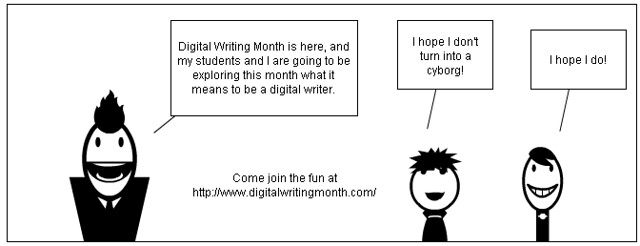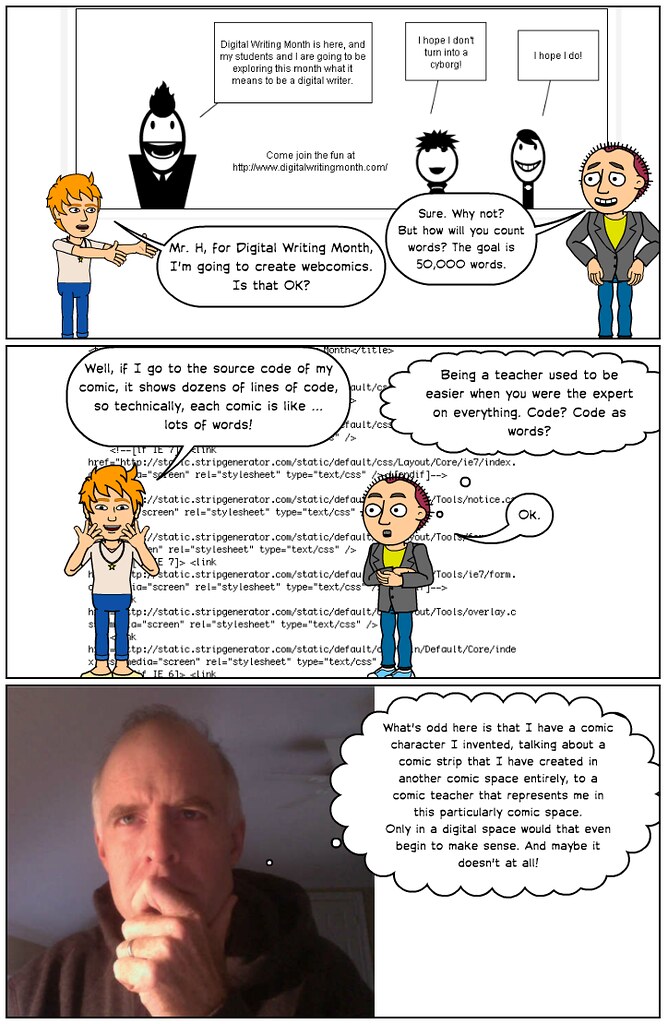
I’m sure others will have a better insider’s look at Digital Writing Month‘s monumental collaborative project from yesterday entitled “Novel in a Day.” The goal was to use a Google Doc to create a novel of 50,000 words in 24 hours by as many people as possible, writing vignettes. In the end, it was just over 41,000 words, apparently. And about 55 writers were writing on the document yesterday throughout the day (the theme was using the mascot of the month — Digi the Duck — in vignettes.) A collaborative planning session in another Google Doc the night before narrowed down the focus of the novel, which I thought was a neat way to bring many voices into the mix.
I added two pieces — Vignette 9, which was about the duck trying to write a poem but he can’t reach the keyboard, and Vignette 28, told through a text message in which Digi asks Mickey Mouse for some advice. I had an idea for a third piece, but my oldest son was hogging the computer with some friends (ironically, they are writing a collaborative movie script) and by the time they were done, I was nearly asleep. Ack.
Here are some observations from my own experiences being inside and outside the Novel-in-a-Day idea:
- The novel is long. I know that is a “duh” moment but I was so caught up in the writing that I barely had time to read what others were up to. In that situation, the vignette concept was brilliant. But it often felt like I was more of an isolated writer than a collaborative writer. I also had a lot of other things going on during the day, so I wasn’t fully immersed in the experience. I’m pretty sure a few folks were working to tie threads of the stories together. I made an attempt in mine, but I am not sure I was all that successful.
- At some points, there were more than a dozen folks just lingering around in the document. I think some people wrote elsewhere and then pasted their text in. I wrote directly in the Google Doc. I had this feeling of being watched. I didn’t mind it so much but it was an odd experience. Another time, I was trying to start a new vignette, but the person writing the piece before mine kept on typing, and as I was trying to write, I was messing up their text. I could “see” them pause, try again. I’d wait, try, and mess them up. After two times, I gave up, thinking Google Docs must be on a bender. I hope that other writer forgives me.
- The collaborative element was a key component but I was hoping for more ways to push barriers with text, as part of the inquiry with Digital Writing Month. One writer did something interesting: using the idea of anchors, he created a series of “make your own adventure” choices for the reader. I may have missed it, but most of what is in the novel is traditional text. Odd storytelling, and very creative, but still very traditional: words on paper/screen. The third vignette that I did not write was going to be a story converted into html code, with a message embedded within the code. I really am sorry I missed that chance. I was hoping for a video vignette, or maybe some audio. There were some images sprinkled here and there. Of course, it was just 24 hours. I need to be realistic with my expectations.
- Does this translate to the classroom? Yes, and I have done collaborative stories like this with my sixth graders on wikis, using colors to show a change in writers. What this kind of activity does is allows you to talk about voice, and collaborative technology, and the focus of a story (which often gets lost).
- Was it worth it? Heck, yes. I love how technology can bring collaborators together to try new things. Although I was not one of the planners or organizers, who should feel pretty good this morning about the novel experience, I feel connected to the success of the writing experience. It’s not about the word count; it’s about the experience.
Peace (in the novel),
Kevin










